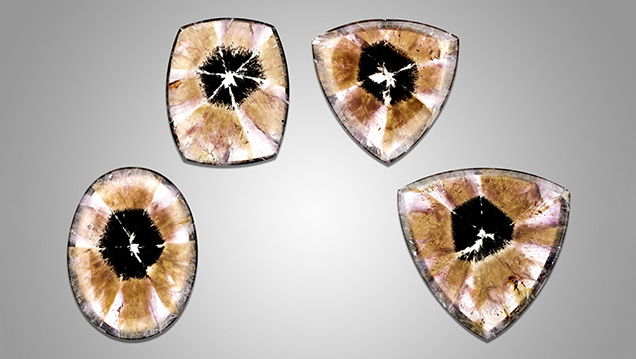Trapiche-like Amethyst from Brazil

Minerals such as corundum, beryl, tourmaline, and quartz, which belong to either the trigonal or the hexagonal crystal system, can show a trapiche-like texture with a hexagonal core and six extended arms when viewed down the c-axis. Four trapiche-like amethyst cabochons (figure 1) were submitted to GIA’s Carlsbad laboratory by L. Allen Brown (All That Glitters, Methuen, Massachusetts) for scientific examination. Each was characterized by a hexagonal black core and six brownish arms with pale purple color zoning in between. Magnification revealed that the black core was composed of dense metallic dendritic inclusions (figure 2, left). The brown color of the arms was caused by numerous tufts of tiny inclusions (figure 2, right), some of which resembled either brushes or bullets.
Raman spectra were collected with a Renishaw inVia Raman microscope system. The confocal capabilities of the system allowed inclusions beneath the surface to be analyzed. The black core was identified as an FeS2 (iron sulfide) mineral, likely pyrite. The brownish tiny inclusions in arms could not be identified but were likely goethite (E.J. Gübelin and J.I. Koivula, Photoatlas of Inclusions in Gemstones, Vol. 2, Opinio Verlag, Basel, Switzerland, p. 558) based on appearance and occurrence in quartz matrix.

The texture of trapiche-like amethysts is often caused only by the distribution of color-inducing elements (K. Schmetzer and B. Williams, “Gem-quality amethyst from Rwanda: Optical and microscopic properties,” Journal of Gemmology, Vol. 36, No. 1, 2018, pp. 26–36). The fact that the texture was caused by two sets of distinctly colored inclusions makes these four gemstones unique.



